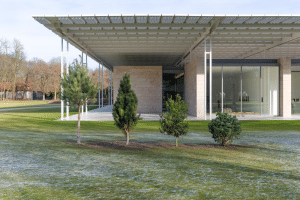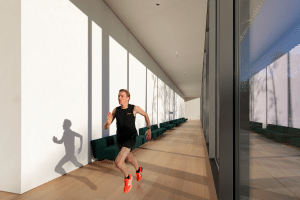Joop van Caldenborgh, founder of Museum Voorlinden in Wassenaar, has commissioned a classical museum that builds on existing conventions about presenting art. The art should be central and the building does not matter, so to speak. Yet the design plays an important role.
Architecture critic Tim de Boer dives deeper into the thoughts behind the building, and how they work out in practice.
Between the balloons it was silent and dark. I was lying on my back. With every movement, static crackled down the hall. Was this what Martin Creed had in mind? I stand up. It gets lighter and lighter around me. At last I have a clear view upwards. There are leaves and sand on the glass roof of the hall. With difficulty, I get out of the hall (the balloons want to come with me but are not allowed to) and walk straight into a hellish room. Dozens of metronomes are ticking, all in a different beat, jumbled together. I wish this were a nice analogy for Voorlinden Museum could be. The quiet museum world rudely shaken up by the arrival of the new building. But I don't see it that way.
Of course, a private individual building his own museum to display his collection of art is not common in the Netherlands. It is a special and commendable undertaking. Moreover, the collection consists of fantastic works that will not easily be seen in any other museum. And yet: in the set-up of the museum and the building, something falters.
Secondary school
Arrival is typically Dutch. No monorail (Getty Centre, Los Angeles) or boat (MONA, Hobart). Just a car park with a stereotypical bike park that wouldn't be out of place at a high school. It is ten past eleven, the car park is almost full. It is raining lightly. Apparently more people think it's a beautiful day for the arts. However, I decide - primal Dutch - to start with coffee. The restaurant occupies the entire ground floor of the old manor house. It takes a while to find a place in the labyrinth of rooms. In summer, you have nice views of the garden and landscape from the terrace, but on this day in February, there is unfortunately no connection to the art inside.
The new museum building, designed by Dirk Jan Postel of Kraaijvanger, lies a little further on. With lazy curves, the path winds between the manor house and the museum before arriving at the entrance halfway down the long back of the museum. It is a fine diversions, even in the rain.
Messy effect

The roof creates conditions for displaying the art inside. The special hole pattern filters southern light to the right strength. This varies from room to room. Because of the open space between the roof and the museum, you would expect the roof to be an autonomous part of the building. However, it leans on four long walls and a single glass facade via short legs. The walls can be recognised outside by the natural stone. Where the roof crosses, thin, double columns have been chosen, reflecting the dimensions of the walls. The space between the 'hole roof' and the actual building is exposed to the elements and appears mostly cluttered.
The unusual roof structure is influential by filtering light inside but is itself almost invisible. The structure of the rooms feels pleasant. Partly because the public address system and emergency lighting are hidden behind the stucco, the rooms feel hushed. Yet it also feels unbalanced, because the art does have signs hanging everywhere. It detracts from the simplicity of the presentation. Other museums such as the aforementioned MONA or Insel Hombroich also leave this out, leaving even more room for one's own experience of the art.

Out of balance
And again someone ran hard past. The running people from Creed reassured me. It was a pleasant way to measure time as I pondered on the one of the benches in the long corridor - overlooking the landscape. Everyone runs differently. So still constantly watching how someone runs, how someone turns the corner and comes back. Martin Creed's work is characterised by its active presence. They are all experiences that throw you off balance in the museum.
In the building, walls and large areas of glass alternate. The design tries to blend inside and outside by using continuous lines between inside and outside. This has partly succeeded. This is because relatively thick window frames were chosen that are not concealed in the floor and walls. This thickness is because sometimes the roof also rests on these posts and then it is striking that they are actually very slim again. The corner solutions in the glass façade differ everywhere. You miss an unambiguous approach. Also, the luxurious natural stone contrasts greatly with the cheap finish of the window frames and eaves. These are small things, but they are the difference between an ordinary and a perfect building.
Classic library
The unbalanced elaboration of the design shows that the architect was strongly directed by the client. This happens more often with this type of commission. The architect wants a project like this all too much and takes the restrictions for granted[ref]Even Richard Meier had to go to the Getty Center in Los Angeles content to design the exterior, whereen he was also forced to deviate from his penchant for white cladding[/ref]. At Voorlinden, you can see this best in the library. This one feels incredibly classic. The design language and materials used do not fit the museum's atmosphere. And that's because the library, shop and auditorium were designed by Italian interior architect Andrea Milan, without consulting Postel.
It made me wonder why the library was not given a place in the old manor house. That would have been more appropriate in terms of atmosphere. The restaurant, as part of the new building, could then have established a relationship with the art.
Lazy art experience
It is unfortunate that Caldenborgh has built a classical museum, which would possibly be so subsidised even within the Dutch cultural system. A contrarian or idiosyncratic approach is missing. Symptomatic of this is perhaps the raised gallery next to the gigantic and impressive sculpture Open Ended by Richard Serra. The inside experience, the puzzling in your head of the 'how can this be' is negated by a simple staircase, a gallery and overview.

Hopefully, Martin Creed's active exhibition is the beginning of the growth of a few quirky spines.
< Did you like the article? Then pay the author via Blendle >
